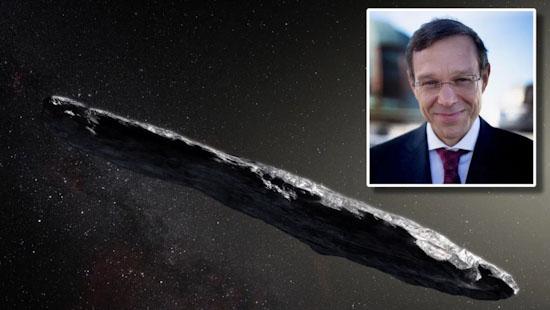A Harvard professor says an alien visited in 2017 and more are coming
Posted on January 4th, 2021
Courtesy The Daily Mirror
When the first sign of intelligent life first visits us from space, it won’t be a giant saucer hovering over New York. More likely, it will be an alien civilization’s trash.

Avi Loeb, the chair of Harvard’s Department of Astronomy, believes he’s already found some of that garbage.
In his upcoming book, Extraterrestrial: The First Sign of Intelligent Life Beyond Earth” (Houghton Mifflin Harcourt), out Jan. 26, the professor lays out a compelling case for why an object that recently wandered into our solar system was not just another rock but actually a piece of alien technology.
The object in question traveled toward our solar system from the direction of Vega, a nearby star 25 light-years away, and intercepted our solar system’s orbital plane on Sept. 6, 2017.
On Sept. 9, its trajectory brought it closest to the sun. At the end of September, it blasted at about 58,900 miles per hour past Venus’ orbital distance, and then, on Oct. 7, it shot past Earth’s before moving swiftly toward the constellation Pegasus and the blackness beyond,” Loeb writes in the book.
The object was first spotted by an observatory in Hawaii containing the Panoramic Survey Telescope and Rapid Response System (Pan-STARRS) — the highest definition telescope on earth.
The space object was dubbed ‘Oumuamua (pronounced oh moo ah moo ah”), which is Hawaiian for — roughly — scout.”
As space travelers go, it was relatively small at just about 100 yards long, but it was a big deal in the scientific community.
For starters, it was the first interstellar object ever detected inside our solar system. Judging from the object’s trajectory, astronomers concluded it was not bound by the sun’s gravity — which suggested it was just traveling through.
No crisp photos could be taken, but astronomers were able to train their telescopes on the object for 11 days, collecting reams of other data.
At first, scientists thought it was an ordinary comet. But Loeb said that assumption ran the risk of allowing the familiar to define what we might discover.”
What would happen if a caveman saw a cellphone?” he asked. He’s seen rocks all his life, and he would have thought it was just a shiny rock.”
Loeb soon opened his mind to another possibility: It was not a comet but discarded tech from an alien civilization. (nypost)
January 16th, 2021 at 2:30 pm
To me it looks like a big projectile thrown out to the space by a massive volcano, because of it’s shape managed to easily move within the universe. So far we have not received any meaningful signals from a civilization outside our planetary system. I am sure this universe is so vast, there bound to be many planets with living beings, perhaps of the primitive kind. There is a possibility that we are too primitive to sense any signals or sense any activities from them. One day when we improve from digital to another method of sending/receiving signals, then we might be able to discover their singles, perhaps we may not be able to decode or simplify it to ,our standards. We may be even be too far away from nearest planet with conditions suitable for life and the living being there are advance or even primitive enough to our level of communication.